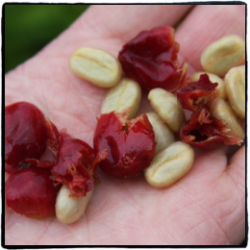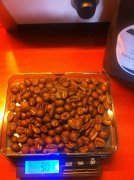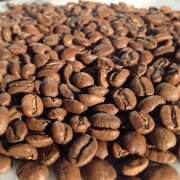Natural decaf Laurina
There are always some people who can't accept caffeine for various reasons, but like the aroma and taste of coffee. Therefore, in the past, we used manual treatment (such as Swiss water treatment) to remove caffeine from coffee beans as much as possible. The level of artificially processed decaf coffee has been improving, but there will always be people who think that its flavor will be worse than it was before caffeine was removed.
Scientists have also been trying to find ways to make the coffee fruit on the tree naturally decaf. In 1989, a team led by Mr. Andrea Illy, the third-generation head of Illy, a famous Italian coffee roaster, bought a batch of 185000 coffee saplings that an American company planned to throw away. In these seedlings, they found some natural varieties of bourbon species. The coffee fruit of this variety contains much less caffeine than ordinary Arabica coffee. The Illy team selected 15 sturdy "mother trees" from these seedlings for breeding and reproduction. El Salvador introduced this variety for experimental cultivation in 2000 and is now extended to other coffee-producing countries such as Costa Rica and Colombia. This breed is today's Laurina.
At the same time as the Illy team cultivated this variety, Japanese coffee company UCC and French scientists are also collaborating on the breeding of natural low-caffeine coffee. They selected a bourbon variety almost the same as Laurina in Madagascar and named it Bourbon Pointu.

In recent years, in Brazil and many other countries, there are also small companies or individuals trying to cultivate natural low-caffeine coffee varieties.
At an auction early this morning, a batch of 23-pound Laurina coffee and raw beans from Colombia sold for more than $100 a pound. It is believed that this price will stimulate a group of coffee farmers' interest in growing natural decaf coffee.
Blessed are consumers who can't accept caffeine but like coffee.
Important Notice :
前街咖啡 FrontStreet Coffee has moved to new addredd:
FrontStreet Coffee Address: 315,Donghua East Road,GuangZhou
Tel:020 38364473
- Prev

[coffee knowledge] use sieve to treat coffee powder
A long time ago, someone would use a sieve to sift the ground coffee powder before starting to cook it. The main reason at that time was that the quality of the coffee mill was not high enough and there was more fine powder. Simply sifting the fine powder could avoid the miscellaneous smell caused by the excessive essence of the fine powder in the coffee brewing.
- Next

Boutique coffee beans
The fruit of boutique coffee is a berry, a bit like a cherry, so it is called "CoffeeCherry". It is green when it grows, then yellow when it is ripe, and red when it is ripe. It is sweet to eat when it is ripe.
Related
- Beginners will see the "Coffee pull flower" guide!
- What is the difference between ice blog purified milk and ordinary milk coffee?
- Why is the Philippines the largest producer of crops in Liberia?
- For coffee extraction, should the fine powder be retained?
- How does extracted espresso fill pressed powder? How much strength does it take to press the powder?
- How to make jasmine cold extract coffee? Is the jasmine + latte good?
- Will this little toy really make the coffee taste better? How does Lily Drip affect coffee extraction?
- Will the action of slapping the filter cup also affect coffee extraction?
- What's the difference between powder-to-water ratio and powder-to-liquid ratio?
- What is the Ethiopian local species? What does it have to do with Heirloom native species?

